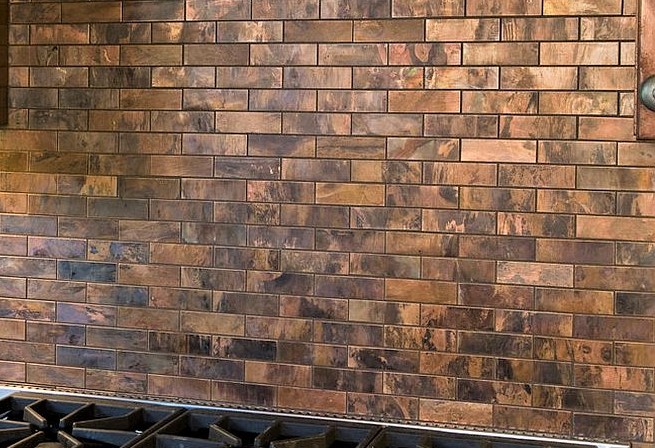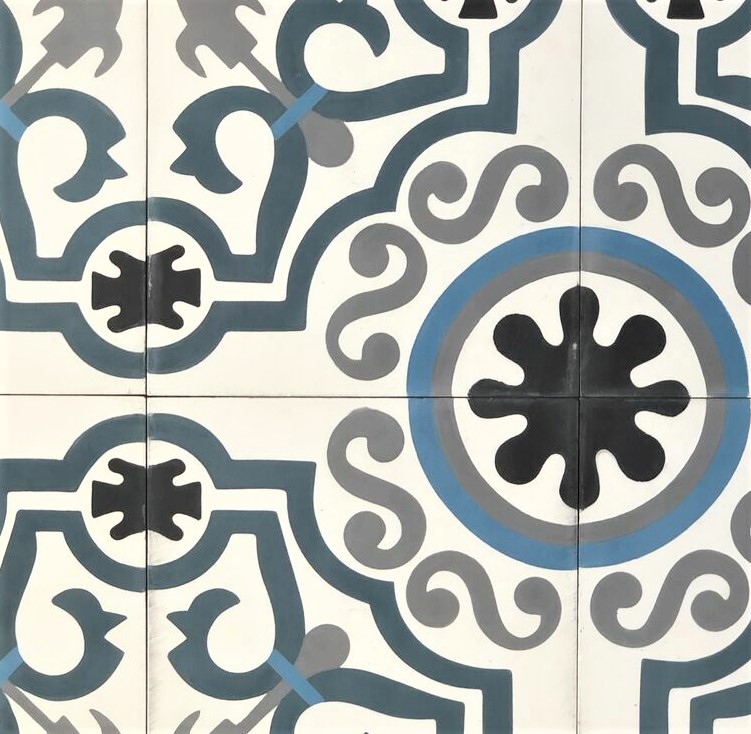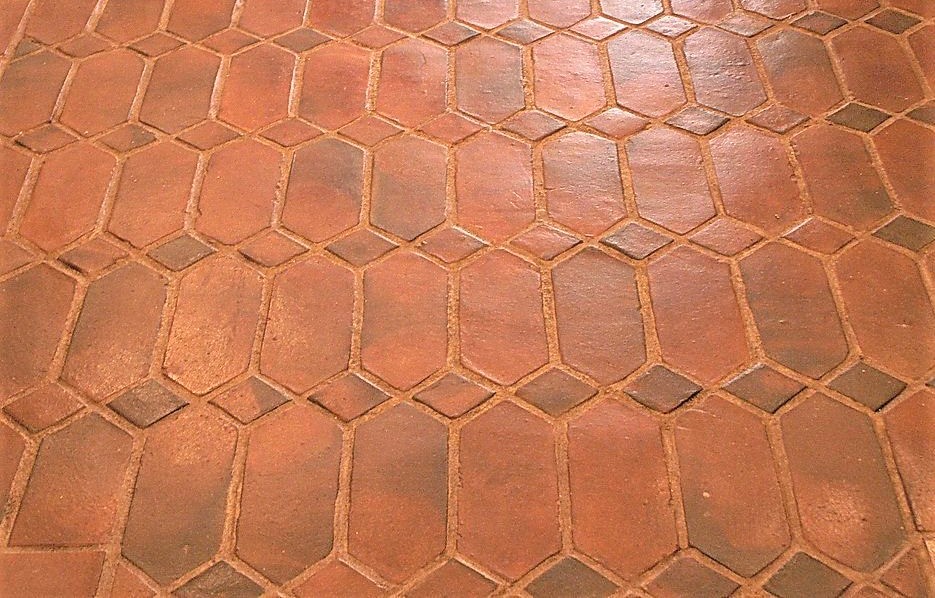Trouble Tile

Custom Concrete Tile
From Hank in Redmond: “I saw a tile on a home repair show that I really liked. I ordered some for a bath remodel and the installer said it wasn’t right for use in a shower. Why would they use it in a shower on the show?”
The producers of home repair shows are often given products and paid a fee to use them. Watch enough shows and you’ll see the same tile or fixtures on many of them. The show producers may not know the difference, or may have accepted the advertising description of the tile without looking a little deeper (see agglomerates below).
From Pam in West Seattle: “We moved into a home with a terracotta floor in the kitchen that always looks dirty. Can you fix it?”
Terracotta is a type of earthenware tile that absorbs stains and soil. The original designer might have meant for patina to be part of the look of the kitchen. We could make it look better…but unfortunately, the only way to regain a “like new” appearance is to replace the floor. We’ll cover this in more depth later.
We often see tile installations that start out looking great, but too soon fail to live up to expectations. Today’s tile can be rugged, homey, glamorous, easy to live with … and also expensive, fragile and difficult to care for.
We’re going to shed some light on the most popular products in the tile world…from our perspective of course. That is, when tasked with returning a tile surface to that like-new condition.
(This article is longer than usual, so find a comfy chair and refreshments.)
The five general categories we see the most, listed in reverse order of popularity and complexity:
- Metal
- Glass
- Stone
- Agglomerates
- Ceramics

Metal
Metal tiles are rarely solid metal; they’re typically a thin layer of metal glued to a ceramic or resin backing. Some are coated with a clear plastic to prevent oxidation; some have no coating so the metal can gain a desired patina of corrosion when in use.
If you’re making a ‘brassy’ statement in a wet area, check with the manufacturer to make sure the tile is rated for that use. Also remember that extremely shiny surfaces will show hard water and soap residue, so the shiny shower will require continuous maintenance.
Both the plastic coating and the metal itself are prone to scratches, so cleaning must be done with non-abrasive products. Since wear and scratches go together, we’d suggest checking out ‘metallic finish’ tile if you want the look of metal on the floor.

Glass
Glass absorbs no water. This makes it stain proof, and though glass can be etched with a strong enough acid, fruit and cosmetic strength acids won’t hurt it. The transparency that makes glass a good design choice also makes scratches more visible, so it may be a risky choice for a working kitchen counter or as flooring.
Cleaning is easy if hard water deposits are not allowed to build up. Avoid using scrubbing pads or any cleaner containing abrasives, they can also leave tiny scratches that will dull the finish. A pro can polish a marred glass surface but removing a scratch deep enough to be felt with a fingernail may result in visible surface distortion.
Stone
The main drawback to using stone is typically cost, although some stone will cost less than some types of tile. The chemical sensitivity and hardness of stone varies, and not all stone is appropriate for all uses. In general, limestone, travertine and marble are softer and more prone to damage from grit and stains than granite or slate. Softer stone typically takes more effort to maintain.
More information about stone can be found here: D. A. Burns Soft-Rock Blog

Poured in Place Terrazzo Floor
Agglomerates
Agglomerate is defined as “things formed into a group.” In the tile world agglomerates consist of particles of quartz, stone, glass, sand and other material mixed with some type of adhesive binder. Concrete is an example of stones and sand bound using cement. Quartz slab or tile is an example of a ground quartz crystal bound using a polyester or epoxy resin.
Concrete and traditional Terrazzo are cement-bound products.
Hundreds of years ago terrazzo was made by inserting marble chips into clay to make smooth pathways. Today it may still be made in-place using cement or a resin binder and also comes in tiles that may contain other stone types. Concrete is available in tiles with a printed surface, custom dyed to match your eyes, or custom molded and embossed to emulate the detailed tile of a vintage fireplace surround.

Printed Concrete Tile

Faded Concrete Tile
Cement, and some stone used in terrazzo, can be damaged by grit and acidic household products.Since cement tiles are not hardened by heat, they need to be thicker than other tiles to avoid breakage. As with earthenware, cement-based products are prone to scratches and wear. Work surfaces require the use of cutting boards, and floors should be protected by using walk mats at entrances. Cement is absorbent and needs to be treated with a penetrating sealer. Although some cement tiles are advertised for use in showers, we don’t recommend either water permeable or matte-finished products for that purpose.
- Soil and stain absorbent, gaining a patina that can’t be completely removed by cleaning.
- Custom-dyed concrete may lose color with use and cleaning. Makers say the color can be brought back by sanding the surface to expose fresh color.
- Custom concrete tiles used in fireplace surrounds may require a colorist to re-stain the tile after cleaning. (See link at the end)
- Printed designs may be thin and wear-sensitive.
Handmade Concrete Tile Making Video
Quartz is the most common resin bound product. Not to be confused with quartzite, which is a natural stone, quartz is made by crushing quartz crystals and mixing them with a plastic resin. Quartz crystals are hard, and the synthetic binders are not water absorbent, so quartz has earned a reputation as a pretty carefree product and a practical choice for use in wet areas.
Concerns with quartz are related to the resin binder and are common to many plastics.
- The resin binder may be sensitive to heat from a hot pan, hair dryer or floor heating elements.
- Sunlight can cause some quartz/resin products to discolor.
- The resin will wear faster than the quartz; areas of heavy wear can become dull.
- Certain oils can penetrate and/or damage the resin.
These issues are most noticeable in tile with higher resin content. Typically, the more expensive products use a smaller percentage of binder so have fewer problems, and darker colors will show less discoloration.
You’ve reached the halfway point!
The next section is about ceramic tiles, the largest and most diverse portion of the tile world. The differences between ceramic types and coatings can be pretty important when it comes to cleaning and durability.
All ceramics are made from clay and fired (baked) to make them tough. Differences in additives or firing time and temperature allow the creation of different products from a similar clay base. Additional variations are created by adding surface coatings that may be printed, hand-painted or spray applied, and then may be fired again to create a hard, waterproof glaze.
Ceramics can be divided into three main types:
- Earthenware
- Stoneware
- Porcelain

Saltillo aka Mexican Tile, Spanish Tile
1 – Earthenware: Terracotta, Spanish Tile, Saltillo, Brick…
Earthenware tiles are the oldest form of manufactured replacement for stone. Many are still made by hand-pressing clay into forms and baking in relatively low temperature ovens. The hand-crafted look can be just right for a particular space, and unless the tiles are re-claimed from an ancient Italian monastery, earthenware tiles should be less expensive than other tile.
Earthenware tiles can be uneven in shape and thickness, and like concrete, need to be thicker than other tile types to avoid breakage. It is the most porous type of fired clay tile and has no added layer of pigment or baked-on finish, and since clay mixing is limited, the finished product will have color differences.
Earthenware must be sealed before installation to keep grout color from seeping into the tile, and it readily absorbs moisture, oils and stains. Discoloration over time should be expected. Even sealed, earthenware should not be used in wet areas, as moisture will still get into the tile. Used outdoors in our climate, moisture can freeze and cause breakage.
Some makers recommend adding an acrylic top coat over an application of penetrating sealer to make day to day care a little easier.
NOTE: We recommend using an acrylic product if a top coat is used. Polyurethane is tougher, but both types will eventually have soils ground in and will need to be removed and reapplied. Removing acrylic build-up is messy and time-consuming. Removing polyurethane is very messy and can require the use of some pretty harsh chemistry, which can be costly.
If you’re concerned with a retaining a new appearance, there are stoneware tiles that emulate the look of earthenware and require less care.
Saltillo Terracotta Production Video
2 – Stoneware: ceramic tile, quarry tile, brick
Stoneware is what we typically think of as ceramic tile. Stronger and less porous than earthenware, stoneware most often has a hardened glaze applied to the face that makes it shed water. Stoneware may contain other minerals and sand along with clay and will be fired at a higher temperature than earthenware. It’s stronger, which means it can be thinner and lighter.
Ceramic tiles may be fired and then have a glaze applied and be fired again. The glaze acts almost like glass to create a permanent, tough seal and color coat. Glazed stoneware can chip when impacted by tracked-in grit or metal furniture legs but is generally easy to care for.
Problems with stoneware are mostly related to the glaze. Some tiles have a microscopically thin glaze that will scratch easily, or just have a printed or painted surface. To achieve a fashionably dull surface, some will have no glaze at all. Unglazed stoneware acts like a tougher version of earthenware – it will still absorb stains.
It can be difficult to tell that a tile has a fragile coating surface, so the Porcelain Enamel Institute (PEI) has developed a rating system to provide an easy way to tell if a particular product will be right for your project – a surface wear rating scale of 0 to 5.
- Rating 0 has no protective coating.
- Rating 1 should only be used on dry interior walls.
- Rating 2 is OK for light traffic, such as residential bathrooms.
- Rating 3 is OK for slightly heavier traffic in residential applications.
- Rating 4 is good for commercial spaces such as a professional office.
- Rating 5 is for commercial applications with heavier foot traffic.
We suggest looking for the PEI rating when buying tile for any new project, as tile marketing is often misleading. We’ve seen advertising for a tile that says, “Grade 1, first quality for floor and wall use” with a pictogram of a hammer hitting it, and photo of the tile used on a stairway. The specifications for the same tile: PEI Rating 2, suitable for light foot traffic such as powder rooms. This could be what confuses remodeling show producers.
Quarry tile differs from other stoneware. It can appear similar to the natural look of earthenware, but adding feldspar and shale and firing at 2000 degrees makes it tough enough to be used outdoors and in wet areas. Unglazed quarry tile is often used in commercial spaces because it has a natural non-slip surface. Unglazed quarry tile will still stain though, so the glazed version could be a better choice for a residential kitchen.
Brick in the stoneware category is more like quarry tile, a different composition and firing temperature creates a harder, less porous product. This is the building-grade brick used in exterior construction today.
3 – Porcelain
Porcelain is made with ground quartz and other materials blended with fine clay and fired at even higher temperatures to make an almost glass-like ceramic. Being harder makes it difficult to cut, so slightly higher installation cost will add to the higher cost of porcelain over stoneware ceramic tiles. Many remodelers use it on the floor or in showers and use less expensive products on walls. Porcelain tiles should have a Grade 5 PEI rating and absorb very little moisture, resulting in low maintenance, with only a few concerns:
- Shiny finishes can show scratches.
- Matte finishes naturally show fingerprints and other oily marks.
- Some porcelain tile is made with a printed surface that is not durable.
A tile maxim is, “Tiles aren’t bad, the end user just has to use them in the right places.” Luckily, we have a lot of good tile shops that can answer questions for future projects, and maybe we can help with existing tile installations.
If you have stone, tile and grout that needs cleaning, give us a call at 206.782.2268. We’re happy to help.
For those that would enjoy knowing more we’ve included some links and references below.
Britannica Porcelain Article with Sub-Links
Custom Tile Maker and Colorist Catalogue
Photo and information credits:
- Rustico Flooring
- Building Design and Construction
- Italy tile
- Britannica
- Tile Magazine
- Decoist
- Buildipedia
- Marazzi tile
